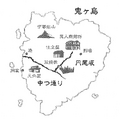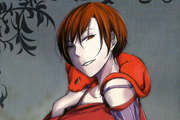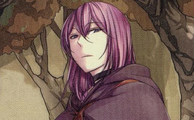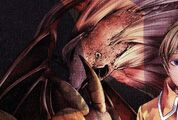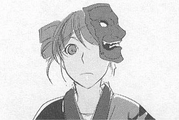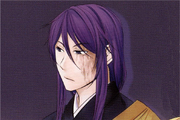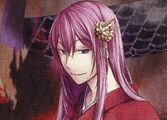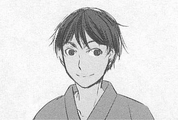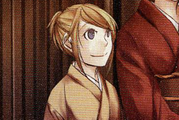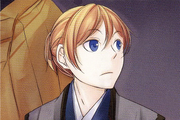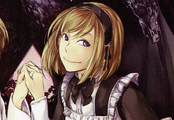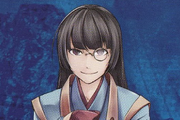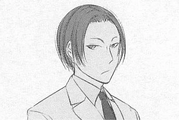Jakoku[note 1], originally the nation of Jamataikoku[note 2], was a state in the Bolganio continent's Akuna region. Historically isolating itself from other nations, the country maintained limited contact with the Evillious region before being opened to foreign trade.
History[]
Early History[]
Founded long before the establishment of the Evillious Calendar, "Jamataikoku" dominated the archipelago under the Netsuma Clan's leadership. During this period, there was a cultural exchange with the countries to the west. When the nation collapsed toward the end of the BT era, many Netsumas immigrated to the mainland en masse. After that, "Jakoku" came to control the islands, but as time progressed, it underwent constant changes in government while refusing to accept foreigners or their culture within their borders. By the end of the first century EC, the Netsuma population in Jakoku became extinct.[1] At some point, the nation adopted the Evillious Calendar.
Civil War[]
Around EC 540, the country was divided into warring states constantly fighting over control of each other's territory. During the conflict, Amayomi's daimyo Nobunaga Hatsune successfully conquered much of the nation before being betrayed and killed during a revolt between his subordinates. His daughter, Jahime, took up his banner and fought with the Tokugawa Clan over control of the entire archipelago. After the Battle of Jagahara in EC 549, the country was unified under the Eto shogunate[1] and a new ruler was crowned, ending the civil war.[2] Afterward, Gaou Octo was promoted to magistrate of the Izami region and Onigashima and opened up for limited trade and immigration with foreigners in EC 590.[1]
Western Outreach[]
In December of EC 838, Enbizaka was ravaged by a large fire. Following the fire, the Freezis Foundation and Yarera-Zusco Firm funded the town's reconstruction.[3] In EC 842, the Miroku Family was brutally killed; shortly after, Kayo Sudou was arrested and executed for the murders.[4] In EC 852, Perrié Cutie Marlon arrived with Maistian warships and forced the shogunate to open its borders for foreign trade with the entire nation; facing resistance from the Crimson Robed Masses, Perrié's forces wiped them out. After the chaos, the Eto shogunate dissolved.[1] In EC 993, Jakoku entered an alliance with Beelzenia and Elphegort in the west. After the United States of Maistia declared their support for the Union State of Evillious during their war with Elphegort, Jakoku pulled Maistia into the ensuing conflict, joining the worldwide war.[5]
World's End[]
In EC 998, Onigashima was destroyed by Punishment due to a targeting miscalculation.[6] In EC 999, the rest of Jakoku was completely decimated by Punishment.[7] Following the end of the Third Period and its subsequent merging with the Hellish Yard,[8] an illusion of Enbizaka was created by Kayo Sudou. Around that time, an illusion of the USE Dark Star Bureau courthouse created by Gallerian Marlon materialized in the city.[9] The Master of the Hellish Yard later arrived and returned Gallerian and Kayo to lower hell.[10]
Government and Politics[]
Power Structure[]
Following the collapse of Jamataikoku, Jakoku's government constantly changed throughout the centuries before entering a warring states period where each region was governed by the local daimyo. Following the end of the Jakoku Civil War, the nation's government was united under the rule of the shogunate, with a shogun ruling over all the daimyo. Below them were the magistrates, samurai charged with ruling the shogunate's territories in its stead. Each position within the government was subject to a hereditary line-of-succession with the firstborn male usually inheriting the position and title.
Military[]
Jakoku's military maintained the elite samurai as its backbone. Prominent samurai families were given positions of authority as magistrates to maintain civil order in their region. They typically wielded katana.
Economy[]
Jakoku maintained a feudal system, with peasants of a territory required to farm the fields for the nation's agriculture. In exchange, peasants were presumably given a moderate fee or permitted to live on the land they worked and take a small portion of the harvest. Jakoku also maintained a sizable merchant class selling various goods domestically. While maintaining a strict isolationist policy throughout much of its history, Jakoku continued to have limited trade with other nations outside of Onigashima until freeing trade with the rest of the world. Among its products, Jakoku developed a sauce that became popular in the western region of the continent.[11] The kimono was also a notable product of the nation in the west.[12]
Society and Culture[]
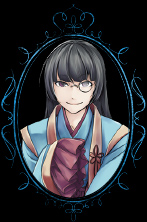
A typical Jakokuese
Due to their historical isolation from Evillious, the Jakokuese had a limited tolerance of foreigners, with only the community of Enbizaka allowing the intermixing of natives with foreigners and immigrants.[13] Compounding this, disdain for foreigners existed in other communities outside Onigashima, with those without the characteristics of pure Jakokuese being discriminated against.[14] Extremists opposed to any foreign influence within the nation were also present within Jakoku for several centuries.[15]
Jakoku had a unique culture separate to that of the western world,[16] although said culture eventually spread to Evillious through trade. Part of this culture was the nation's fashion, with the Jakokuese typically wearing kimonos as standard attire.[17] Jakoku also had a unique cuisine,[14] part of this being the famous "Jakoku sauce" present in Evillious.[11]
As part of its unique culture, Jakoku maintained a local faith,[14] which involved belief in reincarnation as well as concepts such as the Heavenly Yard in the Levin faith, albeit under the name "Sukhavati".[18] Monks within the faith existed, whose duties included funeral rites for criminals. Aside from this, sutra chants existed as a form of prayer for the faith.[19] Local magic users were also present in Jakoku even until the civil war period.[20]
Technologically, Jakoku was generally on par with Evillious, although having its own inventions and designs. One of these was the katana, which was utilized by the nation's elite samurai.[21] Jakoku also maintained its own language and writing system,[22] as well as a unique calendar system before it adopted the EC system. Despite these developments, Jakoku was behind Evillious with regards to medicine.[3] Because of its isolation, Jakoku was considered one of the unexplored kingdoms of the East by the 6th century EC.[23]
Geography and Climate[]
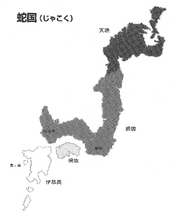
Map of Jakoku
As an archipelago, Jakoku lay off the main continent of Bolganio in the eastern end of Akuna region. It also had several smaller islands branching off from the main island. Due to having water on all sides, the country had a natural barrier protecting its borders.[24] The nation had a relatively mountainous landscape but had a diverse enough geography to possess both warm and snowy climates. Aside from this, a disease endemic to the country existed within the archipelago.[20]
Locations[]
Amayomi[]
Amayomi[note 3] was a region in northern Jakoku. It was part of the main landmass, and contained an island.
Enkoku[]
Enkoku[note 4] was a region in central Jakoku. The shogunate's headquarters was located in the capital city of Eto. It was part of the main landmass.
Momogengou[]
Momogengou[note 5] was a small village located on the western edge of Enkoku. It had a different name until the EC 500s when the 1st Saruteito changed it to Momogengou. The Rangu Clan lived in a settlement near the area.
Susa[]
Susa[note 6] was a region in southeast Jakoku. It was an island off the main landmass.
Izami[]
Izami[note 7] was a region in southwest Jakoku. It contained numerous islands, including Onigashima. Following Jakoku's civil war, it was governed by the noble Okuto Clan.
Onigashima[]
Main Article: Onigashima
An island in Jakoku's Izami region. The small island was located off the southern shore of the main island. Following the nation's civil war, all foreigners within Jakoku were deported to the island; it later became Jakoku's hub for foreign trade. The city of Enbizaka was located at its center.[1]
Jagahara[]
Jagahara[note 8] was a major plain in Jakoku. During the civil war in EC 549, the Battle of Jagahara took place on the plain, ending the conflict.[1]
Known Residents[]
Trivia[]
Conceptualization and Origin[]
- Jakoku is inspired by the real world nation of Japan; its culture and appearance bears many similarities with that of feudal Japan.
- Its name is written as 蛇国 in Japanese kanji, literally meaning "snake country"; fittingly, the Jakoku archipelago resembles a large snake.
- The name Jamataikoku is written as 蛇魔台国 in Japanese kanji, using the kanji for "snake", "demon", "stand" or "table", and "land" or "country", respectively.
- Its association with snakes may be a reference to the Leviathan, the patron demon of Envy; in Judeo-Christian mythology, the Leviathan is often depicted as a type of large sea serpent.
- Additionally, snakes are often the representative animal of Envy in Western symbolism.
Gallery[]
Appearances[]
- The Journey of Two Mages ~Great Wall and Watchman~ (appears in PV)
- The Tailor of Enbizaka (first appearance)
- The Weathered Head at Onigashima
- The Muzzle of Nemesis (mentioned in PV)
- Heartbeat Clocktower (appears in PV)
- Seven Crimes and Punishments (alternate timeline; illusion)
- The Daughter of Evil: Clôture of Yellow (mentioned only)
- The Daughter of Evil: Wiegenlied of Green (mentioned only)
- The Daughter of Evil: Praeludium of Red (indirect mention only)
- The Daughter of Evil: Praefacio of Blue (indirect mention only)
- Deadly Sins of Evil: The Lunacy of Duke Venomania (mentioned only)
- Deadly Sins of Evil: Evil Food Eater Conchita (mentioned only)
- Deadly Sins of Evil: Gift from the Princess who Brought Sleep (indirect mention only)
- Deadly Sins of Evil: Fifth Pierrot (mentioned only)
- Deadly Sins of Evil: The Tailor of Enbizaka
- Deadly Sins of Evil: Judgment of Corruption (mentioned only)
- Deadly Sins of Evil: The Muzzle of Nemesis (mentioned only)
- Deadly Sins of Evil: Master of the Heavenly Yard (mentioned only)
- Original Sin Story: Crime (mentioned only)
- Entr'acte of Evil: The Daughter of Evil Worldguide
- Epic of Evil: The Daughter of Evil Fanbook (mentioned only)
- Waltz of Evil: The Deadly Sins of Evil Guidebook
- Heavenly Yard (story)
- Evil Food Eater Conchita: Setsubun (non-canon appearance; indirect mention only)
- The Daughter of Evil: The Doll Festival (non-canon appearance; mentioned only)
- Seven Crimes and Punishments (story) (alternate timeline; illusion)
- The Daughter of Evil (manga) (indirect mention only)
- Deadly Sins of Evil (manga) (non-canon appearance)
- Quartets of Evil (non-canon appearance)
- Evils Forest
- Evils Kingdom
- Original Sin Story -Act 1- (mentioned only)
- The Muzzle of Nemesis (album) (mentioned only)
- Seven Crimes and Punishments (album)
- Clockwork Lullaby (album) (alternate timeline; illusion)
References[]
- ↑ 1.0 1.1 1.2 1.3 1.4 1.5 Deadly Sins of Evil: The Tailor of Enbizaka – End-of-book Documents
- ↑ "Heavenly Yard"
- ↑ 3.0 3.1 Deadly Sins of Evil: The Tailor of Enbizaka – Chapter 1, Act 2
- ↑ Deadly Sins of Evil: The Tailor of Enbizaka – Chapter 3
- ↑ The Muzzle of Nemesis – Timeline
- ↑ Deadly Sins of Evil: The Muzzle of Nemesis – 1
- ↑ "Seven Crimes and Punishments" – Wrath
- ↑ "Seven Crimes and Punishments" – Prologue
- ↑ "Seven Crimes and Punishments" – Envy
- ↑ "Seven Crimes and Punishments" – Greed
- ↑ 11.0 11.1 Deadly Sins of Evil: Evil Food Eater Conchita – Soup
- ↑ The Daughter of Evil: Praefacio of Blue – Epilogue
- ↑ Deadly Sins of Evil: The Tailor of Enbizaka – Chapter 1, Act 1
- ↑ 14.0 14.1 14.2 Deadly Sins of Evil: The Tailor of Enbizaka – Chapter 1, Act 6
- ↑ Deadly Sins of Evil: The Tailor of Enbizaka – Chapter 1, Act 3
- ↑ Deadly Sins of Evil: The Lunacy of Duke Venomania – Chapter 1
- ↑ Epic of Evil: The Daughter of Evil Fanbook – Aftermath – Chartette
- ↑ Deadly Sins of Evil: The Tailor of Enbizaka – Chapter 5
- ↑ Deadly Sins of Evil: The Tailor of Enbizaka – Chapter 2
- ↑ 20.0 20.1 Deadly Sins of Evil: The Tailor of Enbizaka
- ↑ The Daughter of Evil: Clôture of Yellow – Chapter 2, Section 1
- ↑ Deadly Sins of Evil: The Tailor of Enbizaka – Chapter 1, Act 4
- ↑ The Daughter of Evil: Wiegenlied of Green – Epilogue
- ↑ Evils Kingdom – Chronicles of Evillious





